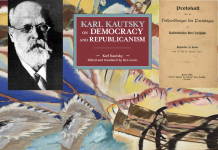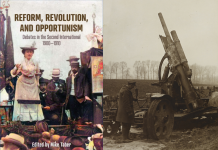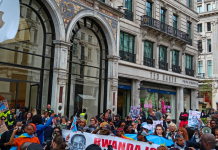The Historical Materialism conference that took place in London earlier this month continued important debates around social reproduction and intersectionality. Here, Colin Wilson introduces the concept of social reproduction and summarises the discussions that took place in meetings with Tithi Bhattacharya, Alan Sears, Hester Eisenstein, Kate Davies and Lise Vogel.
What is “social reproduction”?
The first plenary of Historical Materialism, and many meetings that followed, addressed issues around social reproduction. Social reproduction has become something of a buzzword since the recent republication of Lise Vogel’s important book Marxism and the Oppression of Women. What does it mean?
Marx argues that capitalism depends on the extraction of social value from workers during production – in everyday terms, making profits depends on workers continuing to labour. This means that it’s in the interest of capital to ensure that it continues to have a labour force available – that the current labour force is reproduced in the future.
A central way this happens in most capitalist societies is through the family, where the next generation of workers is raised. The existence of the family allows capital to reduce its spending on social reproduction, for example by cutting welfare and care services and relying on families to provide them instead. Because women are expected to do this caring work – and do most of it in practice – social reproduction theory provides a Marxist account of women’s oppression which links the social situation of women to capital’s search for profit.
The family, however, isn’t the only way in which capital seeks to ensure the availability of a workforce. Migration has been a key aspect of capital from the beginning – in the case of Britain, the arrival of thousands of Irish people in the mid-nineteenth century, and since the Second World War of people from the Caribbean, the Indian subcontinent, Eastern Europe and elsewhere. Earlier, capital in its period of “primitive accumulation” depended on the enslavement and forced labour of millions of African people. In fact, for much of the eighteenth century in the British and French Caribbean, biological reproduction – slaves giving birth to children – played a minor role in social reproduction. The social reproduction of the slave workforce was, rather, ensured by continually buying slaves newly brought from Africa.
A final introductory point is that social reproduction is not just about the presence of sufficient physical bodies, but the development of a workforce of socialised individuals with the skills capital needs. So social reproduction includes the provision of care, education and housing, for example. As capital tries to reduce spending in these areas, or to make them better fit the needs of capital, they have increasingly become sites of class struggle. Some authors, including Tithi Bhattacharya, have stressed the strategic importance for socialists of connecting workplace struggles with wider issues in working-class communities, as Chicago teachers did during their strike.
Tithi Bhattacharya: Marx, labour and social reproduction
Tithi Bhattacharya began the meeting by considering Marx’s description of the interaction of the labouring human body and the surrounding material world. Humans make the world around them through labour, labour which is not instinctive but conscious. As Marx points out, while bees always create perfect six-sided cells, human architects create various structures. Through labour, humans create the world around them, and so they also change own nature. This challenges a common-sense version that Marxism is primarily about economics and wage labour.
But if we create our world and create ourselves through our labour, why do we dread Monday morning? It’s the result of the violence capitalism wreaks on our human capacity for sensuous and purposive labour. We work for capital, not for ourselves. Labouring, under capitalism, also creates our bodily selves and our historical subjectivity. Capitalism reproduces itself through the continuous consumption of human labour. Workers become poorer the more we produce, the objects workers produce confront us as something alien. The capitalist labour process is thus an alienating wedge into a unity of consciousness, the bodily self and nature. Capitalism separates the biological and social worlds, which ought to be a sensuous whole.
Our world seems to be an ensemble of commodities – these inanimate commodities which confront the sensuous being of the worker, diminishing our selfhood and impoverishing us. This is why Marx begins Capital with an account of the commodity. Yet under capitalism we only inhabit an aspect of reality, not its totality. For example, everyone is formally equal, but in fact the means by which we produce our lives are based on a violent dispossession, appropriation by a few. The real inequality inherent in capitalism is only plain if we go beneath the surface reality of things.
Capitalism relies on the extraction of surplus value – human labour becomes wage labour within the capitalist production process. The sensuous unity of the body, the self and purposive labour is broken down into labour performed only to sustain the worker – what Marx called alienation. In his writing on alienation, István Mészáros’s identifies labour, (in German, Arbeit), as its key converging point – an alienation which divorces the individual from the social and the natural from the self-conscious.
We live then in a society where the sensuous unity of self, body and purposive labour has been broken apart. Gender under capitalism is an aspect of this disunity. Gender – either in opposition to biology-sex, or as the linear expression of biology-sex – is one of the many irreconcilable dualisms which capitalism claims we inhabit. Our task must be to investigate the conditions of possibility under capitalism of both gender and sex and seek the relationship they both have to the wider totality of our being. Lise Vogel’s work shifts the former focus from women’s domestic labour to the structural relationship of the family to the realm of capitalist production. Women’s oppression in the domestic sphere can’t be separated from the totality of capitalist production.
The extraction of surplus value, then, is contradictory – it’s both the process through which capital preys on the lives of its subjects, and the landscape where the battle between labour and capital, for example over the length of the working day and general working conditions, takes place. The wage system both measures out exploitation and provides the opportunity to take action, such as strikes, to disrupt capitalism.
Faridabad, an industrial suburb south of Delhi, is part of a huge economic development zone. Millions of people labour here in textiles, cars, software, call centres, factories and slums. Management regularly try to impose speed-ups and rotating shifts which are basically intended to extend production into a 24 hour cycle. Workers in one factory in May took action against this, reports Faridabad Workers News:
During our regular night shifts, the general manager used to be abrasive with any worker he saw dozing. He used to take punitive action against them. One night, 108 of us went to sleep, all together, on the shop floor. Managers, one after the other, who came to check on us, saw us all sleeping in one place and returned quietly. We carried on like this for three nights. They didn’t misbehave with us, didn’t take any action against us. Workers in other sections of the factory followed suit. It became a tradition of sorts.
Workers here protest against speed-up, the reduction in their capacity to replenish their own bodily labour. Workers insisted that their own regeneration take precedence over the extraction of surplus value through their labour. So this is a struggle over the regeneration of the worker, a topic central to social reproduction theory. Secondly, both men and women slept on the factory floor during these overnight protests. Solidarity overcame attempts to introduce divisions along biological or gendered lines. Indeed, it was by blurring the divisions between the realm of workers’ self-reproduction and the factory floor that a new collective fighting body was conceived. The film Salt of the Earth describes a similar process.
Social reproduction theory reveals capital’s role in producing separate spheres of accumulation, labouring bodies and sexed bodies. These spheres must converge, must be made into a single purposive, conscious and metabolic whole for working-class self-emancipation to unfold across capital, sex and gender lines. Resisting bodily the speed-up of capitalist expropriation, replacing labour time with necessary time for the reproduction of life outside of capital relations, transforming the traditionally gendered space of the workplace into a space of resistance to capitalist effects of gender and sexuality – all these are aspects of the emancipatory social relationships which Marx posits as a humane alternative to capital.
Alan Sears: Social reproduction and sexual liberation
Alan Sears continued the meeting by developing an account of sexual liberation struggles. LGBT rights have been won in many places, though LGBT oppression continues and a gap between legal equality and liberation remains. Social reproduction theory offers a means of briding that gap, of moving from formal equality to genuine gender and sexual liberation. It helps us locate sexuality in relation to production and reproduction, and makes clear that sexual normativity is sustained through specific divisions of labour. Sexual liberation is inseparable from, but can’t be reduced to, collective and democratic control over the social organisation of labour and an end to dispossession.
Social reproduction theory emerged from the work of Marxist feminists like Joanna Brenner, who asserted that Marxism so far had mainly been concerned with the production of things, but it was also necessary to talk about the production of people. In the 1980s, John D’Emilio did pioneering work which related social reproduction to the emergence of lesbian and gay identities. He argued that the development of wage labour, as opposed to people living in interdependent family units, made it possible for same-sex desire to coalesce into a personal identity based outside the family. Peter Drucker has taken this further in Warped, his recent book, by historicising same-sex identities within capitalism and examining how they shift as capital reorganises divisions of labour and reconfigures working life.
Social reproduction underlies the organisation of work and life which leads to what Gayle Rubin has called “sex-gender systems”. Production and reproduction in capitalism depend on processes of dispossession where the direct producers are deprived of control over the resources they need to sustain life. In Marx this is a one-off process of “primitive accumulation”; in more recent authors such as David Harvey and Sylvia Federici it’s an ongoing process. Rosemary Hennessy has used the term “abjection” to refer to the way that some people are called on to forfeit more of themselves in the labour relations that produce capital. Hennessy argues that abjection is expressed, for example, in the low value given to different kinds of care work. Other abjections would include hierarchical processes of dispossession, such as institutionalised rape cultures. The reproduction of racial hierarchies by modern states through normalised police violence, the prison-industrial complex and immigration detention, that’s also about dispossession as a way of creating differentiated hierarchies.
This process of differentiated dispossession underpins divisions of labour that seem naturalised in capitalist society. Gender differences, and that between paid and unpaid work, draw on these processes and hierarchies of dispossession. So gender, in many ways, doesn’t pre-exist divisions of labour, but is constituted through the work we do. Dorothy Smith argues that women typically have a focus on embodied caregiving, and this is associated with certain ways of knowing and being, while men’s disengagement from taking care of others led to them becoming associated with more abstract ways of knowing.
Gendered patterns of labour and of erotic desire are thus grounded in the constitution of gender through divisions of labour. Divisions of labour tend to create different repertoires of doing and knowing. Judith/Jack Halberstam wrote of a female masculinity which can be constructed through work: some rural women are more masculine by urban standards, simply because they do more manual labour – not because of their sexual desire. Roderick Ferguson has written that African American family forms have tended to be non-heteronormative for example, because the work that African Americans tend to do often doesn’t conform to heteronormative ideals – because of factors from the prison-industrial complex to the fact that African American women are assumed to be able to do different forms of manual labour from white women.
So, if we want to understand sexual liberation and get beyond equality, we have to understand how the heteronormative and the homonormative are tied to particular divisions of labour organised around hierarchies of dispossession. The social reproduction frame reminds us that the organisation of labour has a huge impact on what options we may have to pursue our sexuality. So sexual liberation is not just about transgressive practices, about pushing the envelope more boldly, but also about creating social conditions in which people have the resources and the power control their bodies and lives. Hierarchies of dispossession, the division of labour, the forms of violence involved, all these limit people’s experience of their own bodies. Sexual liberation has to take account of all of these forms of unfreedom, and social reproduction helps bring our attention to that.
Intersectionality and social reproduction
Hester Eisenstein and Kate Davies then spoke: Hester addressed the way that much of modern feminism has aligned itself with neoliberalism, while positions have become available to small numbers of women at the top. As she argued in her book Feminism Seduced, she asserted that feminism has become separated from demands for childcare, control of reproduction and for maternity and paternity leave – from demands which would benefit most women. In her paper, Kate Davison used social reproduction theory to analyse domestic violence in Australia.
I’ve described these papers briefly because I want to move on to discuss a debate which began in the discussion at this session and continued throughout the conference, a debate about the usefulness of the concept of “intersectionality”. Intersectionality isn’t specifically a Marxist concept. It refers to the fact that social/political situations, and the experience of individuals, can involve different forms of subordination – for example, those on grounds of class, race or gender – and highlights the fact that the way these combine isn’t simple. The experiences of black women, for example, are different from both those of black men and those of white women, and aren’t a simple result of the combination of sexism and racism.
Everyone involved in these discussions is committed to fighting oppression, and to understanding how oppression affects the many different groups in society, as part of the social totality of capitalism. But there are debates about how helpful intersectionality is in taking those struggles forward.
For example, Tithi argued, while intersectionality rightly draws our attention to gaps in Marxist theory and our activist work, there are many weaknesses to intersectionality as a theoretical approach. Intersectionality seems to assume that categories like gender or race are each in themselves coherent, singular things that simply intersect, mingle or interact. Also, it gives no account of where these different oppressions came from, or the logic of their interaction. Social reproduction and alienation provide a framework which can explain the origins of oppressions historically, and how they change over time, in a way that intersectionality cannot.
Lise Vogel on intersectionality
These debates continued in the meeting on Questioning Intersectionality, where Lise Vogel gave a paper titled Social Reproduction and Intersectionality. Vogel noted that while the term “intersectionality” was first used by Kimberlé Crenshaw in the 1980s, there had existed in the women’s movement of the 1960s and 70s many examples of what she called “race-class-gender thinking”. Many of these ideas were developed by women of colour such as Claudia Jones and Angela Davis, who wanted to separate themselves from a kind of socialism which always put class first.
In the 1980s, Vogel continued, this approach came to include other factors, such as sexuality. This happened at a time when social movements were in decline, so that by now many feminist scholars had no history of participation in social movements. A story began to be told that feminism had been originally white and middle class, when in fact it had been multi-faceted.
Intersectionality, meanwhile, has several shortcomings theoretically. The term “intersectionality” can mean all kinds of things. Typically, it asserts that systems like race, class and gender are on the one hand autonomous, but on the other hand they are similar and comparable; they interact in some way, but it’s not clear how. This question of interaction is crucial, Vogel suggested, arguing that we have to reject the idea that all systems are of “equal causal weight”. In certain situations we shouldn’t be afraid to go back to “class first”.
In the discussion a particularly interesting contribution was made by Jamie Gough, citing a distinction made in the work of the Marxist author Bertell Ollmann. Gough argued that intersectionality is only really interested in concrete examples. But Marx/Ollman make a distinction between internal relations, where there is a logical relation between two things, and external relations, where two things coincide but there is no necessary casual link. Intersectionality gives an account based on contingent, external relations, but it’s the internal relations which are important.
Ferguson and McNally on social reproduction and intersectionality
Finally, while they didn’t give papers at HM, it’s useful to refer to an interview with the Canadian Marxists Sue Ferguson and David McNally in the recent issue of Viewpoints magazine devoted to social reproduction. Ferguson and McNally highlight the importance, for them, of social reproduction theory. First, it unearths the fact that labour power has a social existence and a history, unlike previous versions of Marxism which tend to assume it as given. Labour power in fact only continues to exist because of certain gendered and sexualised social relationships outside of the direct labour-capital relation. Second, social reproduction theory focuses attention on the fact that the continuation of capitalism requires the existence of both paid wage labour and unpaid work: the theory presents, as they put it, “a complexly differentiated yet nonetheless unified understanding of social totality.”
While they recognise some strengths in intersectionality, Ferguson and McNally also describe fundamental weaknesses. For example, they argue that
the best intersectionality accounts have rightly insisted that it is impossible to isolate any particular set of oppressive relations from the other. Yet they’ve not developed any coherent explanation of how and why, for instance, heterosexualized relations intersect with patriarchal relations in some ways and not others (why the family, though its form changes over time to accommodate, for instance, same-sex marriage, nonetheless remains a private institution through which heteronormativity and patriarchy are routinely if not always affirmed). One reason for this has to do with intersectionality feminism’s inadequate theorization of the social totality, the overall processes or dynamic in and through which discrete social relations intersect… this means, of course, that despite claiming distinct oppressions are co-constitutive, they are in fact treated as ontologically distinct systems, crisscrossing or inter-meshing in space.
And so, while recognising that it needs further development in some areas, they find social reproduction theory a more fruitful approach than intersectionality:
While intersectionality theory has raised important questions, and generated important insights, it tends to flounder at explaining why these multiple oppressions exist and are reproduced throughout late capitalism, and at accounting for the how of their interaction. Because its approach is holistic and unitary, social reproduction theory is, we think, potentially better equipped in these areas. But this requires a lot of work, and a real commitment to learning from the best of anti-racist and anti-colonial theory and practice, in order to overcome some significant shortcomings of early social reproduction theory.
And, to conclude, it’s worth citing the political conclusions they draw from social reproduction theory:
Let’s agree that capitalism’s reproduction requires something more than the direct labour/capital relation, “economic” exchanges and laws of motion – that in fact it critically depends upon the messy, complex, set of lived relations carried out by differently gendered, sexualized, racialised human beings. If this is the case, then we need to also realize that racialised, sexualized, gendered bodies, practices, and institutions matter: racism and sexism are not historical aberrations that can somehow be separated from capitalism’s “real” or “ideal” functioning. Rather, they are integral to and determinant of – in the sense that they really and actively facilitate – actual processes of capital dispossession and accumulation. By the same reasoning, challenging racism, sexism, or any oppression that impacts the social reproduction of labour-power, can hinder the reproduction of capital.
It is in this sense that “movement” or non-workplace struggles are class struggles. That is, they are themselves potentially anti-capitalist in essence, just like a workplace struggle is always incipiently anti-capitalist… So the political importance of the social reproduction approach lies in its capacity to show the importance of struggling on many fronts, but with an explicit anti-capitalist orientation.





















The power structures benefit white, wealthy, privately educated males who tend to live in the exclusive parts of major cities or grand houses out in the sticks, and then it goes down in scale to a graded hierarchical structure not unlike a pyramid. This is reality, no more or less. Capitalism needs a demoralised population of people who either work like Trojans to make hay whilst the sun shines or succumb to it and give in and fall by the wayside. More and more we see a closeted and cosseted and wealthy cocooned from any reality whilst millions of people even in wealthy countries are struggling to find decent paying work and something meaningful to do with their lives, and the only ‘meaningful’ thing the wealthy do is make more and more money. Capitalism will eat its own tail, but not before it eats everyone and everything else.
What we also see now is that instead of a unified working class, and genuinely sympathetic middle class people, wedges have been driven very carefully and very cleverly between the economically poor at the bottom, between black and white and Asian, between disabled, gay etc etc, so that each group is really struggling against every other group for a share of the resources, which, far from being a challenge to capitalism, is how capitalism in its rawest state works anyway. We’ve been duped.
Bourdieu is useful to help us get how class and elites are formed through the construction of education to suit a particular world outlook. So he teases out how there is confluence between concerns, attitudes and habits of the bourgeois home ethos and cultural capital and the school curriculum. There’s further work done by someone like Kevin Harris and hardly picked up elsewhere on how the school delivers a ‘secret’ knowledge via its own discipline and mode of governance. To take one tiny example: schools sometimes operate the ‘behaviour chart’. Children are positioned on the chart in terms of how they are behaving. Though this supposedly ‘gives’ children autonomy on how they behave, in fact it denies them autonomy because the structure itself (and who decides your position on the chart) is non-debatable. So, children internalise the power-structure as a ‘given’, conceding the right to ‘authority’ simply because it is ‘authority’ and thereby concedes the very notion that we are ‘bad’ or ‘good’. (Tiny example? Yes, but remember this sort of thing goes on every day, all day from day 1 when we go to school through to 15 or 16. My daughter (14) has analysed the ‘dress code’ rules at her North London comp and quickly figured out that these involve very different assumptions about male and female – namely that a girl exposing a part of herself is punishable and a boy exposing the same part of himself is not. On what basis? That a boy will be enflamed? Aroused? And vice versa a girl will not? So, a girl wearing the ‘wrong’ clothes is to blame for male arousal. However, the point here is also that the system of who decides this is unchallengeable. It’s not even clear, who decides…
The social conditions of the production of human consciousness through the family and school are also vital components of reproduction. Enormous efforts are put in by governments in particular to get this right. They try to control parenting (more accurately ‘nurture’) and schooling in many different ways. A crucial part of this is how children and young people are excluded from decision-making. Nurture and education are, under dominant practices, done ‘to’ children and young people, not done ‘with’ them. These are also points of tension, fracture and resistance in many different ways, so it’s not a picture of uniform oppression.